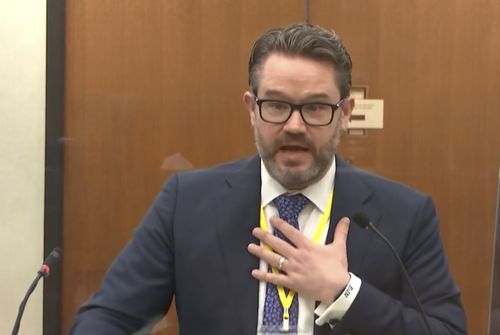Moments after the prosecution rested its case on Tuesday (Wednesday AEST) following 11 days of testimony and a mountain of video evidence, the defence put on its first witness, a retired Minneapolis police officer who testified about a May 6, 2019, incident in which Mr Floyd was arrested.

Scott Creighton said he drew his gun when Mr Floyd, a passenger in a car, did not comply with orders to show his hands.
Mr Nelson played body-camera video showing Mr Creighton approaching on the passenger side, drawing his gun and pulling Mr Floyd out.
Mr Chauvin’s lawyer twice asked questions aimed at getting the jury thinking about Mr Floyd swallowing drugs but Mr Creighton said he did not see the Black man take anything.
Another witness who responded to that call, now-retired paramedic Michelle Moseng, testified Mr Floyd told her he had been taking multiple opioids about every 20 minutes.
“I asked him why and he said it was because he was addicted,” said Ms Moseng, who described Mr Floyd’s behaviour as “elevated and agitated” before the judge struck that remark from the record.
Ms Moseng said she recommended taking Floyd to the hospital, based on his high blood pressure, which she measured at 216 over 160.

On cross-examination, prosecutor Erin Eldridge got Ms Moseng to testify that Floyd’s respiratory output, pulse, heart rate, EKG and heart rhythms were normal.
Ms Eldridge said Mr Floyd was taken to the hospital and released two hours later.
Ms Eldridge also made a point of noting officers gave Mr Floyd contradictory commands, Mr Creighton telling him to put his hands on the dashboard and another officer telling him to put his hands on his head.
She noted another officer threatened to use a stun gun on him, while Mr Floyd asked not to be shot or beaten up.

Judge Peter Cahill cautioned jurors the evidence from the earlier stop was only for the limited purpose of showing the effects opioids might have had on Mr Floyd and that they were not to use it to judge his character.
The prosecution experts rejected the notion his drug use, high blood pressure or heart disease caused his death.
In fact, on Monday (Tuesday AEST), Dr Jonathan Rich, a cardiology expert from Northwestern Memorial Hospital in Chicago, testified: “Every indicator is that Mr Floyd had actually an exceptionally strong heart.”
Mr Chauvin’s lawyer introduced the 2019 arrest to show what he portrayed as a pattern of behaviour on Mr Floyd’s part.
Drugs were later found in his SUV and in the squad car, and fentanyl and methamphetamine were discovered in his system.

In court papers, Mr Nelson wrote that during the 2019 arrest, Mr Floyd wouldn’t listen to officers’ commands, put something in his mouth, had to be removed from a vehicle, then began to cry.
In that case, several opioid pills were found along with cocaine, he and another officer’s attorney wrote.
A third defence witness on Tuesday, Shawanda Hill, who was in the SUV with Mr Floyd before his ill-fated encounter with Mr Chauvin, said Mr Floyd fell asleep at some point and seemed startled when he realised police were there.
When he saw an officer at the window with a gun, Mr Floyd “instantly grabbed the wheel and he was like, ‘Please, please, don’t kill me. Please, please, don’t shoot me. Don’t shoot me. What did I do? Just tell me what I did. Please, don’t kill. Please, don’t shoot me,'” Ms Hill testified.
Mr Nelson also sought to bolster previous suggestions the officers’ actions were influenced by what they perceived as a hostile crowd of bystanders shouting at Mr Chauvin to get off Mr Floyd’s neck.
Minneapolis Park police officer Peter Chang, who helped out at the scene that day, testified he saw a “crowd” growing across the street that “was becoming more loud and aggressive, a lot of yelling across the street.”
“Did that cause you any concern?” asked Mr Nelson, who played footage from the officer’s body camera, on which bystanders can be heard yelling and becoming increasingly frantic.
“Concern for the officers’ safety, yes,” Mr Chang replied.
During the prosecution side of the case, the wrenching video of Mr Floyd gasping for air was played for the jury along with other bystander footage and police body-camera video of the 46-year-old Black man’s slow-motion death after his arrest on suspicion of passing a counterfeit $20 at a neighbourhood market.
Mr Nelson hasn’t said whether Mr Chauvin will take the stand.
Testifying could open him up to devastating cross-examination but could also give the jury the opportunity to see any remorse or sympathy on the officer’s part.
This content first appear on 9news
